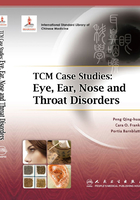
上QQ阅读APP看书,第一时间看更新
COMMENTARY AND DISCUSSION
In Chinese medicine, acute dacryocystitis is referred to as lòu jīng chuāng (weeping canthus sore). As with all eye diseases, the location of the disease identifies the channels that are affected. In this case, the inner canthus belongs to the heart and the eyelid to the spleen.
There are two noteworthy points regarding the physician’s diagnosis: The first; how striking it is that, despite the diagnosis of heat in the heart, the patient has no signs or symptoms normally associate with the spirit. She has not presented with insomnia, anxiety, vexation or agitation. In this case, the heart is involved solely based on the location of the disease; the inner canthus. The second feature of interest is how the physician triages the treatment principles. When treating acute diseases, the branch, or clinical symptoms, are usually addressed first. After, the root causes is treated. In the management of this case, the guiding principle is treating the root condition first. In fact, given that the root cause is an upward attack of toxic heat from the heart and spleen, it would be splitting hairs to distinguish between root and branch treatment strategies. They are being treated simultaneously with the same treatment principles.
The patient is treated with a combination of Huáng Lián Jiĕ Dú Tāng and Wŭ WèiXiāo Dú Yĭn plus tiān huā fĕn, chì sháo and gān căo. The addition of tiān huā fĕn is a reminder to balance the formula by including a moistening medicinal when there is heat and phlegm. Gān căo serves a dual role: in addition to harmonizing the formula, it is detoxifying and moistening.
She is also treated with warm compresses and antibiotic drops, and has the option of making a compress with Rú Yì Jīn Huáng Săn. The ingredients of this are tiān huāfĕn, huáng băi and dà huáng. This strategy is easily replicated in clinical practice. The compress should be made with a well-strained decoction to avoid any small pieces of the medicinals entering the eye.
By the second visit, the patient has improved and the physician determines that toxic fre has been cleared, but some heat remains. He modifes the formula Dăo ChìSăn to match the new presentation. Shēng dì huáng, dàn zhú yè and shēng gān căo are the core medicinals in the formula. Tōng căo is substituted for mù tōng (Caulis Akebiae). The reasoning for this is not explained, however there are likely reasons for the substitution. The frst is to avoid species confusion between mù tōng and chuān mù tōng (Caulis Clematidis Armandii), which contains aristolochic acid, a known nephrotoxin. Another possibility is that, while both medicinals promote urination, clear heat and unblock the channels and collaterals, tōng căo is not biter. Therefore, the nature of tōngcăo is considered less harsh and less drying. We have already observed this physicians concern with the over-use of drying medicinals.
Dăo Chì Săn is further modified with chē qián căo. Here is another excellent example of deliberate medicinal selection. Many practitioners use chē qián zĭ (Semen Plantaginis) to clear heat from the eyes. It is sweet and cold, and enters the bladder, kidney, liver and lung channels. In comparison, chē qián căo has a similar function and taste, however it enters the heart and small intestine channels. It directs heat downward to the small intestine channel. This supports the key action of Dăo Chì Săn. Thus, it can be said that when treating eye disease where the inner canthus is involved, use chē qián căo. For eye diseases involving liver heat, use chē qián zĭ.